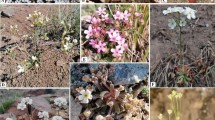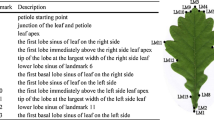Abstract
Multivariate analysis of leaf shape, anatomy, and Fourier-transform infrared (FTIR) data of 27 Camellia species with secretory structures (sects. Archecamellia, Stereocarpus, Furfuracea, Chrysantha), together with three species from related genera, Gordonia and Tutcheria (Theacea), was conducted to clarify some taxonomic problems. Our results show that crystals occurring in adaxial epidermal cells are firstly observed in Chrysantha species, and the secretory structures described are in fact cork warts. Furthermore, we introduce a form coefficient (F c) to assess the shape of epidermal cells, since they are usually irregular and difficult to describe. Pearson correlation analysis indicates that F c is useful to assess epidermal cell shape. Principal component analysis (PCA) of leaf shape indicates that two species from section Archecamellia and two species from section Stereocarpus are significantly different from those in section Furfuracea. Cluster analysis of FTIR data visualizes the degree of affinity among the 30 species examined here, which is consistent with the cluster analysis (CA) of anatomical data, as illustrated in the dendrogram. Therefore, our study indicates that integrated leaf characters based on leaf shape, anatomy, and FTIR data are useful in the taxonomic treatment of Camellia species with secretory structures. Taxonomic controversies among the Camellia species with secretory structures could thus be successfully addressed using only a few intact or small portions of leaves. Moreover, our results tend to support that Chrysantha species should not be merged into section Archecamellia, and that section Heterogenea should not be recognized in taxonomic treatments of Camellia species with secretory structures.












Similar content being viewed by others
References
Ao CQ, Ye CX, Zhang HD (2007) A systematic investigation of leaf epidermis in Camellia using light microscopy. Biologia 62(2):157–162
Baranova MA (1972) Systematic anatomy of the leaf epidermis in the Moagnoliaceae and some related families. Taxon 21:447–469
Baranova MA (1987) Historical development of the present classification of morphological type of stomates. Bot Rev 53:53–79
Briggs D, Walters SM (1984) Plant variation and evolution, 2nd edn. Cambridge University Press, Cambridge
Chang HT (1981) Taxonomy of the genus Camellia. Act Sci Nat Univ Sunyats 1:1–180
Chang HT (1996) Diagnosis on the systematic development of Theaceae VII The taxonomic problem of section Glaberrima Chang of Camellia. Act Sci Nat Univ Sunyats 35:87–90
Chang HT (1998) Theaceae. In: Fl. Reip. Pop. Sin. Editorial Committee (ed) Fl. Reip. Pop. Sin., vol 49. Science Press, Beijing
Chang HT, Bartholomew B (1984) Camellias. Timber, Oregon
Gorgulu ST, Dogan M, Severcan F (2007) The characterization and differentiation of higher plants by Fourier transform infrared spectroscopy. Appl Spectrosc 61:300–308
Hodálová I, Marhold K (1998) Morphometric comparison of Senecio germanicus and S. nemorensis (Compositae) with a new species from Romania. Bot J Linn Soc 128:277–290
Hussin KH, Sani ZM (1998) Comparative leaf anatomical studies of some Sterculia L. species (Sterculiaceae). Bot J Linn Soc 127(2):159–174
Jensen RJ, Ciofani KM, Miramontes LC (2002) Lines, outlines, and landmarks: morphometric analyses of Acerrubrum, Acer saccharinum (Aceraceae) and their hybrid. Taxon 51:475–492
Jolliffe IT (1986) Principal component analysis. Springer, New York
Keng H (1962) Comparative morphological studies Theaceae. Univ Calif Publ Bot 33:269–384
Kim SW, Ban SH, Chung H, Cho S, Chung HJ, Choi PS, Yoo OJ, Liu JR (2004) Taxonomic discrimination of flowering plants by multivariate analysis of Fourier transform infrared spectroscopy data. Plant Cell Rep 23:246–250
Kong HZ (2001) Comparative morphology of leaf epidermis in the Chloranthaceae. Bot J Linn Soc 136:279–294
Lin XY, Peng QF, Lu HF, Du YQ, Tang BY (2008) Leaf anatomy of Camellia sect. Oleifera and sect. Paracamellia (Theaceae) with reference to their taxonomic significance. J Syst Evol 46(2):183–193
Lu HF, Jiang B, Shen ZG, Shen JB, Peng QF, Cheng CG (2008a) Comparative leaf anatomy, FTIR discrimination and biogeographical analysis of Camellia section Tuberculata (Theaceae) with a discussion of its taxonomic treatments. Plant Syst Evol 274:223–235
Lu HF, Shen JB, Lin XY, Fu JL (2008b) Relevance of Fourier transform infrared spectroscopy and leaf anatomy for species classification in Camellia (Theaceae). Taxon 57(4):1274–1288
Lubke RA, Phipps JB (1973) Taximetrics of Loudetia (Gramineae) based on leaf anatomy. Can J Bot 51:2127–2146
Meade C, Parnell J (2003) Multivariate analysis of leaf shape patterns in Asian species of the Uvaria group (Annonaceae). Bot J Linn Soc 143:231–242
Ming TL (1999) A systematic synopsis of the genus Camellia. Acta Bot Yunn 21:149–159
Ming TL (2000) Monograph of the Genus Camellia. Yunnan Sci Technol, Kunming
Ming TL, Zhang WJ (1993) On taxonomic problems of sect. Archecamellia Sealy and sect. Chrysantha Chang in the genus Camellia. Act Bot Yunn 15(1):1–15
Ming TL, Zhang WJ (1996) The evolution and distribution of genus Camellia. Act Bot Yunn 18(1):1–13
Möller M, Gao LM, Mill RR, Li DZ, Hollingsworth ML, Gibby M (2007) Morphometric analysis of the Taxus wallichiana complex (Taxaceae) based on herbarium material. Bot J Linn Soc 155(3):307–335
Mouille G, Robin S, Lecomte M, Pagant S, Höfte H (2003) Classification and identification of Arabidopsis cell wall mutants using Fourier-transform infrared (FT-IR) microspectroscopy. Plant J 35:393–404
Naumann D, Helm D, Labischinski H (1991) Microbiological characterizations by FT-IR spectroscopy. Nature 351:81–82
Neto JC, Meyer GE, Jones DD, Samal AK (2006) Plant species identification using elliptic Fourier leaf shape analysis. Comput Electron Agric 50:121–134
Parks CR, Griffiths A (1963) The saluenensis-pitardit-reticulata complex. Camellia Rev 25(2):12–29
Parnell J, Needham M (1998) Morphometric variation in Irish Sorbus L. (Rosaceae). Watsonia 22:153–161
Plotze RO, Falvo M, Pádua JG, Berbacci LC, Vieira MLC, Oliveira GCX, Bruno OM (2005) Leaf shape analysis using the multiscale Minkowski fractal dimension, a new morphometric method: a study with Passiflora (Passifloraceae). Can J Bot 83:287–301
Premoli AC (1996) Leaf architecture of south American Nothofagus (Nothofagaceae) using traditional and new methods in morphometrics. Bot J Linn Soc 121:25–40
Sealy JR (1958) A revision of the genus Camellia. The Royal Horticultural Society, London
Shen JB, Lu HF, Peng QF, Zheng JF, Tian YM (2008) FTIR spectra of Camellia sect. Oleifera, sect. Paracamellia, and sect. Camellia (Theaceae) with reference to their taxonomic significance. J Syst Evol 46(2):194–204
Sneath PHA, Sokal RR (1973) Numerical Taxonomy. Freeman, San Francisco
Stace CA (1966) The use of epidermal characters in phylogenetic considerations. New Phytol 65:304–318
Stace CA (1989) Plant taxonomy and biosystematics, 2nd edn. Cambridge University Press, Cambridge
Tang SQ, Zhong Y, Su SH, Chang HT (2001) Relationship between C. nitidissima Chi and C. petelotii (Merr.) Sealy based on nrDNA ITS. J Wuhan Bot Res 19(6):449–452
Tang SQ, Bin XY, Wang L, Zhong Y (2006) Genetic diversity and population structure of yellow Camellia (Camellia nitidissima) in China as revealed by RAPD and AFLP markers. Biochem Genet 44:444–456
Upchurch GR (1984) Cuticle evolution in early cretaceous angiosperms from the potomac group of Virginia and Maryland. Ann Missouri Bot Gard 71:522–550
Yang ZR, Lin Q (2005) Comparative morphology of the leaf epidermis in Schisandra (Schisandraceae). Bot J Linn Soc 148:39–56
Ye CX (1993) Annotation of phylogeny in the family Theaceae: a review of sect. Chrysantha Chang and evolution of genus Camellia. Guihaia 13(4):306–310
Acknowledgments
We thank the Institute of Physical Chemistry of Zhejiang Normal University for use of the Nicolet FTIR spectrometer. We are grateful to Prof. Cun-Gui Cheng and Ms. Dan-Ting Li for help with FTIR spectrometer operation and FTIR data analysis. This study was supported by grants from the Natural Science Foundation of Jiangsu Province, China (No. BK2006045) and Open the Foundation of the Botany Key Discipline of Changshu Institute of Technology (No. 2008003).
Author information
Authors and Affiliations
Corresponding author
Additional information
B. Jiang and Q. F. Peng contributed equally to this work.
Appendix 1
Appendix 1
Collection localities and vouchers of studied specimens
GenusCamelliaLinn. SectionArchecamelliaSealy. C. granthamiana Sealy, Jinhua International Camellia Species Garden, Zhejiang Province, China, H.B. Dai 200610190201,02,03 (ZJNU); C. albogigas Hu, Jinhua International Camellia Species Garden, Zhejiang Province, China, H.B. Dai 200610190101,02,03 (ZJNU); Section stereocarpus (Pierre) Sealy. C. liberistyla H.T. Chang, Jinhua International Camellia Species Garden, Zhejiang Province, China, Q.F. Peng 200612100301,02,03 (ZJNU); C. yunnanensis (Pitard) Coh. St., Jinhua International Camellia Species Garden, Zhejiang Province, China, Q.F. Peng 200612100401,02,03 (ZJNU); SectionFurfuraceaChang. C. pubifurfuracea Zhong, Jinhua International Camellia Species Garden, Zhejiang Province, China, H.E. Tian 200610170901,02,03 (ZJNU); C. latipetiolata Chi, Jinhua International Camellia Species Garden, Zhejiang Province, China, H.E. Tian 200610171001,02,03 (ZJNU); C. crapnelliana Tutch., Jinhua International Camellia Species Garden, Zhejiang Province, China, H.E. Tian 200610171101,02,03 (ZJNU); C. multibracteata H.T. Chang et Mo ex Mo, Jinhua International Camellia Species Garden, Zhejiang Province, China, H.E. Tian 200610171201,02,03 (ZJNU); C. furfuracea (Merr.) Coh. St., Jinhua International Camellia Species Garden, Zhejiang Province, China, H.E. Tian 200610171301,02,03 (ZJNU); C. oblata H.T. Chang, Jinhua International Camellia Species Garden, Zhejiang Province, China, Q.F. Peng 200610221401,02,03 (ZJNU); C. gaudichaudii (Gagn.) Sealy, Jinhua International Camellia Species Garden, Zhejiang Province, China, H.E. Tian 200610171501,02,03 (ZJNU); C. gigantocarpa Sealy, Jinhua International Camellia Species Garden, Zhejiang Province, China, Q.F. Peng 200610221601,02,03 (ZJNU); C. octopetala Hu, Jinhua International Camellia Species Garden, Zhejiang Province, China, Q.F. Peng 200610221701,02,03 (ZJNU); C. parafurfuracea S. Y. Liang ex H.T. Chang, Jinhua International Camellia Species Garden, Zhejiang Province, China, H.E. Tian 200610171801,02,03 (ZJNU); C. connatistyla Mo et Zhong, Jinhua International Camellia Species Garden, Zhejiang Province, China, H.E. Tian 200610171901,02,03 (ZJNU); SectionChrysanthaH.T. Chang. C. euphlebia Merr. ex Sealy, Jinhua International Camellia Species Garden, Zhejiang Province, China, H.B. Dai 2006031212301,02,03 (ZJNU); C. limonia C. F. Liang et Mo, Jinhua International Camellia Species Garden, Zhejiang Province, China, H.B. Dai 2006031219401,02,03 (ZJNU); C. achrysantha H.T. Chang et S.Y. Liang, Jinhua International Camellia Species Garden, Zhejiang Province, China, X.F. Wu 2006031612401,02,03 (ZJNU); C. impressinervis H.T. Chang et S.Y. Liang, Jinhua International Camellia Species Garden, Zhejiang Province, China, H.B. Dai 2006031212501,02,03 (ZJNU); C. grandis (Liang et Mo) H.T. Chang et S.Y. Liang, Jinhua International Camellia Species Garden, Zhejiang Province, China, X.F. Wu 2006031612601,02,03 (ZJNU); C. parvipetala J.Y. Liang et Su, Jinhua International Camellia Species Garden, Zhejiang Province, China, H.B. Dai 2006031212801,02,03 (ZJNU); C. pingguoensis Fang, Jinhua International Camellia Species Garden, Zhejiang Province, China, H.B. Dai 2006031219301,02,03 (ZJNU); C. lunzhouensis Luo, Jinhua International Camellia Species Garden, Zhejiang Province, China, X.F. Wu 2006031612901,02,03 (ZJNU); C. huana Ming et W.J. Zhang, Jinhua International Camellia Species Garden, Zhejiang Province, China, X.F. Wu 2006031613001,02,03 (ZJNU); C. liberofilamenta H.T. Chang et C.H. Yang, Jinhua International Camellia Species Garden, Zhejiang Province, China, X.F. Wu 2006031613101,02,03 (ZJNU); C. fusuiensis S.Y. Liang et X.J. Dong, Jinhua International Camellia Species Garden, Zhejiang Province, China, Q.F. Peng 2006011413601,02,03 (ZJNU); C. multipetala S.Y. Liang et C.Z. Deng, Jinhua International Camellia Species Garden, Zhejiang Province, China, Q.F. Peng 2006011413701,02,03 (ZJNU); Genus Gordonia Ellis.G. acuminata H.T. Chang, Jinhua International Camellia Species Garden, Zhejiang Province, China, Q.F. Peng 2006111219701,02,03 (ZJNU); G. longicarpa H.T. Chang, Jinhua International Camellia Species Garden, Zhejiang Province, China, Q.F. Peng 2006111219801,02,03 (ZJNU); GenusTutcheria Dunn. T. hexalocularia Hu et Liang ex H.T. Chang, Jinhua International Camellia Species Garden, Zhejiang Province, China, Q.F. Peng 2006111220101,02,03 (ZJNU).
Rights and permissions
About this article
Cite this article
Jiang, B., Peng, Q.F., Shen, Z.G. et al. Taxonomic treatments of Camellia (Theaceae) species with secretory structures based on integrated leaf characters. Plant Syst Evol 290, 1–20 (2010). https://doi.org/10.1007/s00606-010-0342-x
Received:
Accepted:
Published:
Issue Date:
DOI: https://doi.org/10.1007/s00606-010-0342-x




